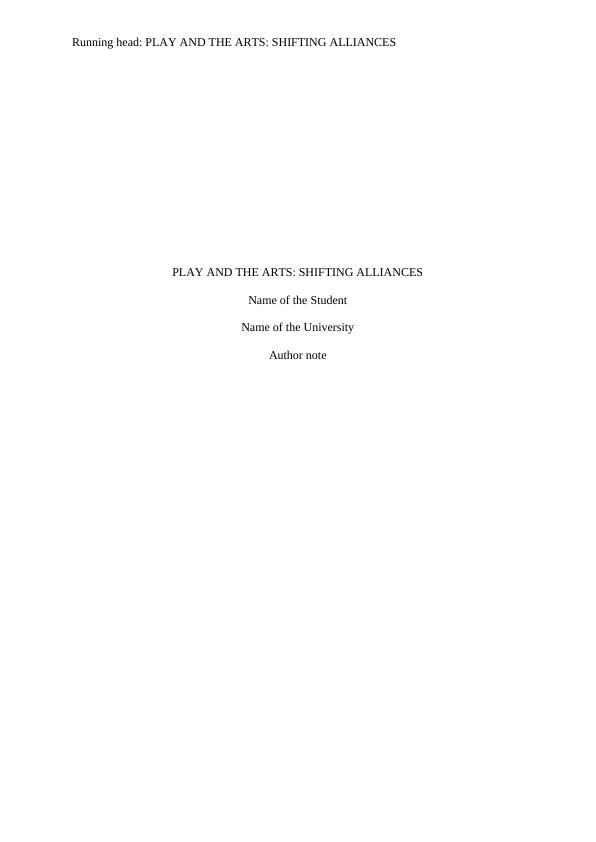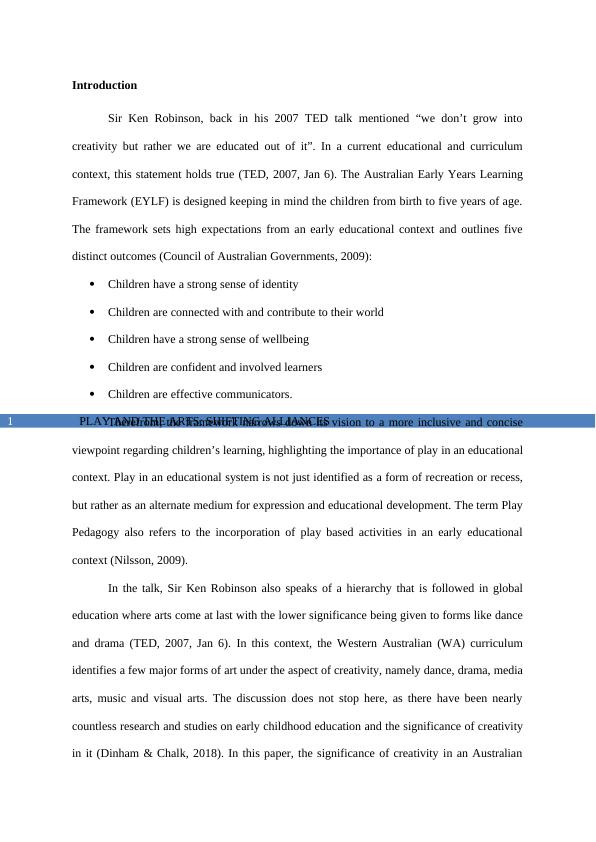Play and the Arts: Shifting Alliances Literature Review 2022
Added on 2022-09-17
10 Pages3072 Words24 Views
Running head: PLAY AND THE ARTS: SHIFTING ALLIANCES
PLAY AND THE ARTS: SHIFTING ALLIANCES
Name of the Student
Name of the University
Author note
PLAY AND THE ARTS: SHIFTING ALLIANCES
Name of the Student
Name of the University
Author note

PLAY AND THE ARTS: SHIFTING ALLIANCES1
Introduction
Sir Ken Robinson, back in his 2007 TED talk mentioned “we don’t grow into
creativity but rather we are educated out of it”. In a current educational and curriculum
context, this statement holds true (TED, 2007, Jan 6). The Australian Early Years Learning
Framework (EYLF) is designed keeping in mind the children from birth to five years of age.
The framework sets high expectations from an early educational context and outlines five
distinct outcomes (Council of Australian Governments, 2009):
Children have a strong sense of identity
Children are connected with and contribute to their world
Children have a strong sense of wellbeing
Children are confident and involved learners
Children are effective communicators.
Therefrom, the framework narrows down its vision to a more inclusive and concise
viewpoint regarding children’s learning, highlighting the importance of play in an educational
context. Play in an educational system is not just identified as a form of recreation or recess,
but rather as an alternate medium for expression and educational development. The term Play
Pedagogy also refers to the incorporation of play based activities in an early educational
context (Nilsson, 2009).
In the talk, Sir Ken Robinson also speaks of a hierarchy that is followed in global
education where arts come at last with the lower significance being given to forms like dance
and drama (TED, 2007, Jan 6). In this context, the Western Australian (WA) curriculum
identifies a few major forms of art under the aspect of creativity, namely dance, drama, media
arts, music and visual arts. The discussion does not stop here, as there have been nearly
countless research and studies on early childhood education and the significance of creativity
in it (Dinham & Chalk, 2018). In this paper, the significance of creativity in an Australian
Introduction
Sir Ken Robinson, back in his 2007 TED talk mentioned “we don’t grow into
creativity but rather we are educated out of it”. In a current educational and curriculum
context, this statement holds true (TED, 2007, Jan 6). The Australian Early Years Learning
Framework (EYLF) is designed keeping in mind the children from birth to five years of age.
The framework sets high expectations from an early educational context and outlines five
distinct outcomes (Council of Australian Governments, 2009):
Children have a strong sense of identity
Children are connected with and contribute to their world
Children have a strong sense of wellbeing
Children are confident and involved learners
Children are effective communicators.
Therefrom, the framework narrows down its vision to a more inclusive and concise
viewpoint regarding children’s learning, highlighting the importance of play in an educational
context. Play in an educational system is not just identified as a form of recreation or recess,
but rather as an alternate medium for expression and educational development. The term Play
Pedagogy also refers to the incorporation of play based activities in an early educational
context (Nilsson, 2009).
In the talk, Sir Ken Robinson also speaks of a hierarchy that is followed in global
education where arts come at last with the lower significance being given to forms like dance
and drama (TED, 2007, Jan 6). In this context, the Western Australian (WA) curriculum
identifies a few major forms of art under the aspect of creativity, namely dance, drama, media
arts, music and visual arts. The discussion does not stop here, as there have been nearly
countless research and studies on early childhood education and the significance of creativity
in it (Dinham & Chalk, 2018). In this paper, the significance of creativity in an Australian

PLAY AND THE ARTS: SHIFTING ALLIANCES2
early educational context has been identified from multiple scholarly articles, journals,
curriculum frameworks and reports. The objective of this paper is to highlight how the nature
of play has shifted over time and how aspects of cultural belonging and cultural competence
is developed with the help of arts.
Literature Review
Current global curricula is rife with examples of highlight on the sciences and
mathematics as well as the humanities. In the current educational scenario, creativity has all
but been obliterated, yet the importance of creativity and play is not completely undermined.
Roskos in his book “Play and literacy in early childhood” highlights that play in an early
educational context is of immense importance as it “supplies the brain with what it needs to
grow: exploring, testing ideas and skills, combining materials and actions, repeating actions
to automaticity, inventing and pretending” (2017, p. x). The nature of play has been viewed
through multiple lenses over time; while in some contexts, parents do not visualise play as an
effective form of academic growth and development, in a recent educational environment,
play is seen as an effective resource to support a holistic development. Swedish scholar
Gunilla Lindqvist in her approaches to play pedagogy has referred to Vygotsky’s theory of
the zone of proximal development as being developed through play as a zone where children
are found to use their highest possible cognitive activity (Nilsson, 2009). There are three
main forms of art namely dance, drama and media arts that are considered the highlights of
this paper as the three factors significantly influencing the development of play in early
education.
Limb movements are identified as one of the most visible determinants of
communication and expression, which is why the art form of dance holds a higher standard
among the performing arts. Dinham and Chalk assert in their book that movement and
dancing should be a routine part of early childhood (2018, p. 144). They also state that
early educational context has been identified from multiple scholarly articles, journals,
curriculum frameworks and reports. The objective of this paper is to highlight how the nature
of play has shifted over time and how aspects of cultural belonging and cultural competence
is developed with the help of arts.
Literature Review
Current global curricula is rife with examples of highlight on the sciences and
mathematics as well as the humanities. In the current educational scenario, creativity has all
but been obliterated, yet the importance of creativity and play is not completely undermined.
Roskos in his book “Play and literacy in early childhood” highlights that play in an early
educational context is of immense importance as it “supplies the brain with what it needs to
grow: exploring, testing ideas and skills, combining materials and actions, repeating actions
to automaticity, inventing and pretending” (2017, p. x). The nature of play has been viewed
through multiple lenses over time; while in some contexts, parents do not visualise play as an
effective form of academic growth and development, in a recent educational environment,
play is seen as an effective resource to support a holistic development. Swedish scholar
Gunilla Lindqvist in her approaches to play pedagogy has referred to Vygotsky’s theory of
the zone of proximal development as being developed through play as a zone where children
are found to use their highest possible cognitive activity (Nilsson, 2009). There are three
main forms of art namely dance, drama and media arts that are considered the highlights of
this paper as the three factors significantly influencing the development of play in early
education.
Limb movements are identified as one of the most visible determinants of
communication and expression, which is why the art form of dance holds a higher standard
among the performing arts. Dinham and Chalk assert in their book that movement and
dancing should be a routine part of early childhood (2018, p. 144). They also state that

End of preview
Want to access all the pages? Upload your documents or become a member.
Related Documents
Learning and Cognition Assignmentlg...
|24
|8241
|14